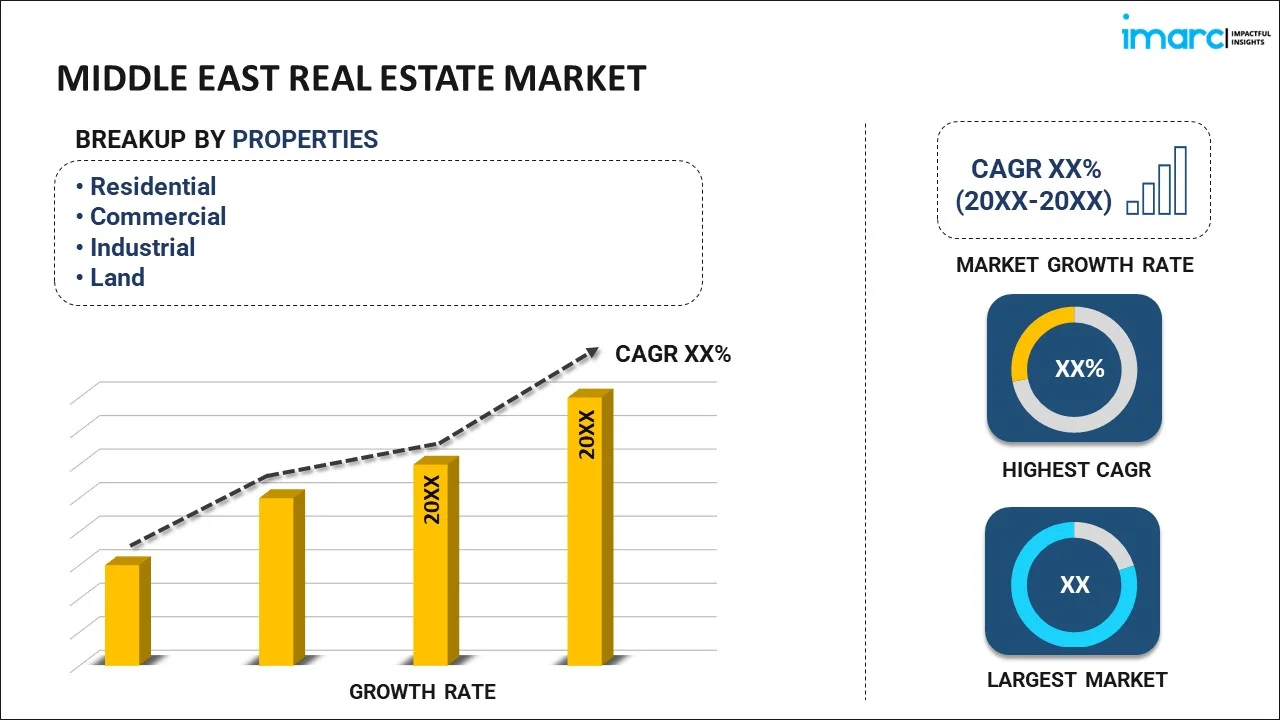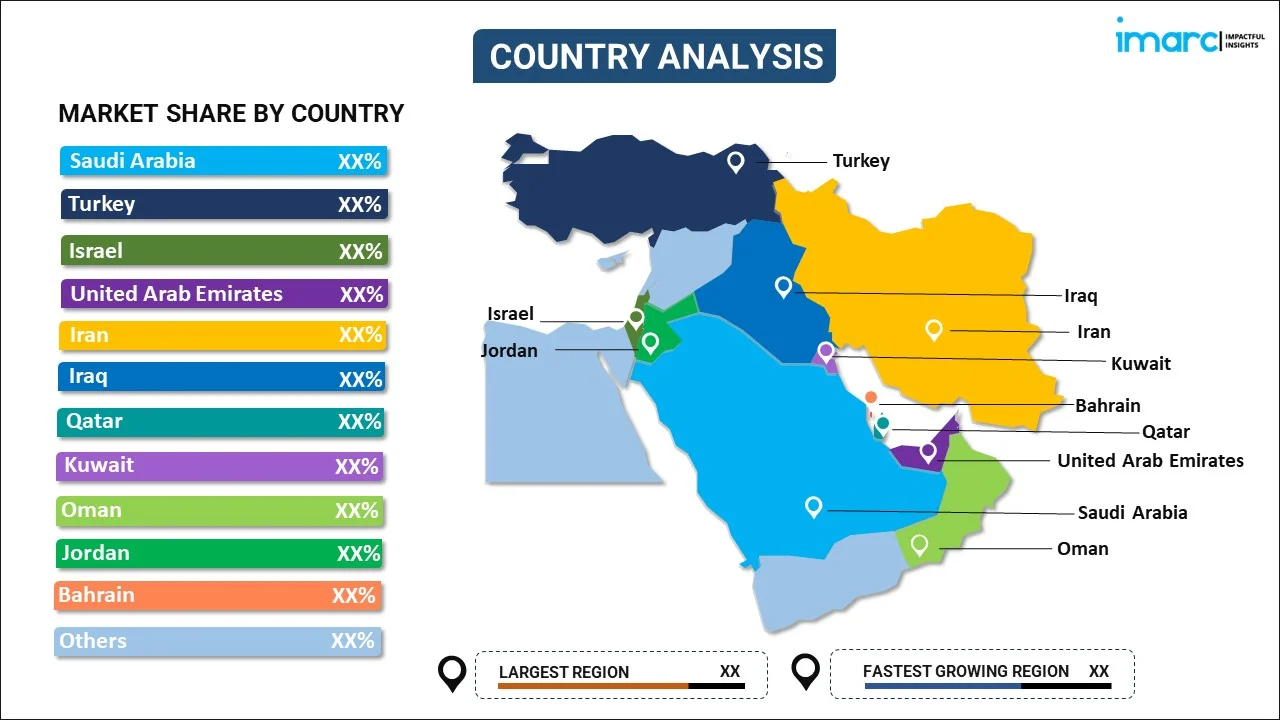
Middle East Real Estate Market Report by Property (Residential, Commercial, Industrial, Land), Business (Sales, Rental), Mode (Online, Offline), and Country 2025-2033
Market Overview:
Middle East real estate market size reached USD 388.7 Billion in 2024. Looking forward, IMARC Group expects the market to reach USD 834.8 Billion by 2033, exhibiting a growth rate (CAGR) of 8.2% during 2025-2033. The rising infrastructure development activities, along with the growing investments in non-oil sectors, are primarily driving the market growth.
|
Report Attribute
|
Key Statistics
|
|---|---|
|
Base Year
|
2024
|
|
Forecast Years
|
2025-2033
|
|
Historical Years
|
2019-2024
|
|
Market Size in 2024
|
USD 388.7 Billion |
|
Market Forecast in 2033
|
USD 834.8 Billion |
| Market Growth Rate 2025-2033 | 8.2% |
Real estate pertains to tangible assets comprising land, buildings, and natural resources, typically acquired or invested in for residential, commercial, or industrial purposes. It encompasses both the physical components and the associated legal rights and interests. Real estate stands as a fundamental element in economies, facilitating housing, business activities, and investment opportunities. Its value tends to appreciate over time, establishing it as a significant means of wealth creation and portfolio diversification. The real estate sector comprises distinct segments such as residential, commercial, and industrial, each characterized by its unique dynamics. Transactions within real estate involve activities like buying, selling, leasing, and property development, playing a pivotal role in influencing urban landscapes and fostering community development.
Middle East Real Estate Market Trends:
The Middle East real estate market is undergoing dynamic changes, reflecting the region's rapid urbanization, economic growth, and evolving demographics. With a focus on both residential and commercial developments, the market is witnessing increased demand for properties catering to diverse needs. Besides this, countries in the Middle East are investing heavily in real estate infrastructure, with iconic projects shaping the skyline of cities, which is acting as another significant growth-inducing factor. Moreover, residential sectors are expanding to accommodate a growing population, driven by factors such as immigration, job opportunities, and lifestyle choices, thereby bolstering the regional market. Additionally, the hospitality and tourism sector is a significant contributor to the real estate market, with luxury resorts and hotels catering to the increasing number of visitors. Investors in the Middle East real estate market are drawn to the potential for significant returns and the region's strategic positioning in the global economy. The market also reflects a growing emphasis on sustainable and innovative building practices, aligning with emerging trends. While each country in the Middle East has its unique real estate dynamics, the overall market is characterized by a blend of traditional and modern architectural landscapes, creating a diverse and vibrant real estate environment. As the region continues to evolve, the market growth across the country will present opportunities for both local and international investors over the forecasted period.
Middle East Real Estate Market Segmentation:
IMARC Group provides an analysis of the key trends in each segment of the market, along with forecasts at the regional and country levels for 2025-2033. Our report has categorized the market based on property, business, and mode.
Property Insights:

- Residential
- Commercial
- Industrial
- Land
The report has provided a detailed breakup and analysis of the market based on the property. This includes residential, commercial, industrial, and land.
Business Insights:
- Sales
- Rental
A detailed breakup and analysis of the market based on the business have also been provided in the report. This includes sales and rental.
Mode Insights:
- Online
- Offline
The report has provided a detailed breakup and analysis of the market based on the mode. This includes online and offline.
Country Insights:

- Saudi Arabia
- Turkey
- Israel
- United Arab Emirates
- Iran
- Iraq
- Qatar
- Kuwait
- Oman
- Jordan
- Bahrain
- Others
The report has also provided a comprehensive analysis of all the major regional markets, which include Saudi Arabia, Turkey, Israel, United Arab Emirates, Iran, Iraq, Qatar, Kuwait, Oman, Jordan, Bahrain, and Others.
Competitive Landscape:
The market research report has also provided a comprehensive analysis of the competitive landscape. Competitive analysis such as market structure, key player positioning, top winning strategies, competitive dashboard, and company evaluation quadrant has been covered in the report. Also, detailed profiles of all major companies have been provided.
Middle East Real Estate Market Report Coverage:
| Report Features | Details |
|---|---|
| Base Year of the Analysis | 2024 |
| Historical Period | 2019-2024 |
| Forecast Period | 2025-2033 |
| Units | Billion USD |
| Scope of the Report | Exploration of Historical and Forecast Trends, Industry Catalysts and Challenges, Segment-Wise Historical and Predictive Market Assessment:
|
| Properties Covered | Residential, Commercial, Industrial, Land |
| Businesses Covered | Sales, Rental |
| Modes Covered | Online, Offline |
| Countries Covered | Saudi Arabia, Turkey, Israel, United Arab Emirates, Iran, Iraq, Qatar, Kuwait, Oman, Jordan, Bahrain, Others |
| Customization Scope | 10% Free Customization |
| Post-Sale Analyst Support | 10-12 Weeks |
| Delivery Format | PDF and Excel through Email (We can also provide the editable version of the report in PPT/Word format on special request) |
Key Questions Answered in This Report:
- How has the Middle East real estate market performed so far and how will it perform in the coming years?
- What has been the impact of COVID-19 on the Middle East real estate market?
- What is the breakup of the Middle East real estate market on the basis of property?
- What is the breakup of the Middle East real estate market on the basis of business?
- What is the breakup of the Middle East real estate market on the basis of mode?
- What are the various stages in the value chain of the Middle East real estate market?
- What are the key driving factors and challenges in the Middle East real estate?
- What is the structure of the Middle East real estate market and who are the key players?
- What is the degree of competition in the Middle East real estate market?
Key Benefits for Stakeholders:
- IMARC’s industry report offers a comprehensive quantitative analysis of various market segments, historical and current market trends, market forecasts, and dynamics of the Middle East real estate market from 2019-2033.
- The research report provides the latest information on the market drivers, challenges, and opportunities in the Middle East real estate market.
- Porter's five forces analysis assist stakeholders in assessing the impact of new entrants, competitive rivalry, supplier power, buyer power, and the threat of substitution. It helps stakeholders to analyze the level of competition within the Middle East real estate industry and its attractiveness.
- Competitive landscape allows stakeholders to understand their competitive environment and provides an insight into the current positions of key players in the market.
Need more help?
- Speak to our experienced analysts for insights on the current market scenarios.
- Include additional segments and countries to customize the report as per your requirement.
- Gain an unparalleled competitive advantage in your domain by understanding how to utilize the report and positively impacting your operations and revenue.
- For further assistance, please connect with our analysts.
 Inquire Before Buying
Inquire Before Buying
 Speak to an Analyst
Speak to an Analyst
 Request Brochure
Request Brochure
 Request Customization
Request Customization




.webp)




.webp)












